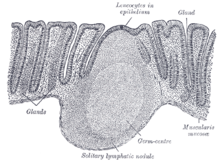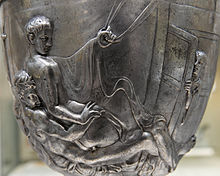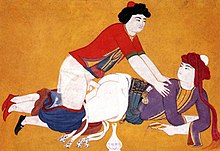Anal sex

Anal sex or anal intercourse is generally the insertion and
Most
As with most forms of sexual activity, anal sex participants risk contracting
Strong views are often expressed about anal sex. It is controversial in various cultures, often because of
Anatomy and stimulation

The abundance of
Research indicates that anal sex occurs significantly less frequently than other sexual behaviors,
In a male
General statistics indicate that 70–80% of women require direct
Male to female
Behaviors and views

The anal sphincters are usually tighter than the pelvic muscles of the vagina, which can enhance the sexual pleasure for the inserting male during male-to-female anal intercourse because of the pressure applied to the penis.[3][41][19] Men may also enjoy the penetrative role during anal sex because of its association with dominance, because it is made more alluring by a female partner or society in general insisting that it is forbidden, or because it presents an additional option for penetration.[5][19]
While some women find being a receptive partner during anal intercourse painful or uncomfortable, or only engage in the act to please a male sexual partner, other women find the activity pleasurable or prefer it to vaginal intercourse.[6][41][42][43]
In a 2010 clinical review article of heterosexual anal sex, anal intercourse is used to specifically denote penile-anal penetration, and anal sex is used to denote any form of anal sexual activity. The review suggests that anal sex is exotic among the sexual practices of some heterosexuals and that "for a certain number of heterosexuals, anal intercourse is pleasurable, exciting, and perhaps considered more intimate than vaginal sex".[6]
Anal intercourse is sometimes used as a substitute for vaginal intercourse during menstruation.[5] The likelihood of pregnancy occurring during anal sex is greatly reduced, as anal sex alone cannot lead to pregnancy unless sperm is somehow transported to the vaginal opening. Because of this, some couples practice anal intercourse as a form of contraception, often in the absence of a condom.[5][37][44]
Male-to-female anal sex is commonly viewed as a way of preserving female
Prevalence
Because most research on anal intercourse addresses
According to a 2010 study from the National Survey of Sexual Health and Behavior (NSSHB) that was authored by Debby Herbenick et al., although anal intercourse is reported by fewer women than other partnered sex behaviors, partnered women in the age groups between 18 and 49 are significantly more likely to report having anal sex in the past 90 days. Women engaged in anal intercourse less commonly than men. Vaginal intercourse was practiced more than insertive anal intercourse among men, but 13% to 15% of men aged 25 to 49 practiced insertive anal intercourse.[50][51]
With regard to adolescents, limited data also exists.[49] This may be because of the taboo nature of anal sex and that teenagers and caregivers subsequently avoid talking to one another about the topic. It is also common for subject review panels and schools to avoid the subject.[49] A 2000 study found that 22.9% of college students who self-identified as non-virgins had anal sex. They used condoms during anal sex 20.9% of the time as compared with 42.9% of the time with vaginal intercourse.[49]
Anal sex being more common among heterosexuals today than it was previously has been linked to the increase in consumption of anal pornography among men, especially among those who view it on a regular basis.[38][39][10] Seidman et al. argued that "cheap, accessible and, especially, interactive media have enabled many more people to produce as well as consume pornography", and that this modern way of producing pornography, in addition to the buttocks and anus having become more eroticized, has led to a significant interest in or obsession with anal sex among men.[10]
Male to male
Behaviors and views

Most homosexual men are reported to engage in anal sex.
Some men who have sex with men, however, believe that being a receptive partner during anal sex questions their masculinity.[53][54]
Prevalence
Reports regarding the prevalence of anal sex among gay men and other men who have sex with men vary. A survey in
Oral sex and mutual masturbation are more common than anal stimulation among men in sexual relationships with other men.[1][56][57] According to Weiten et al., anal intercourse is generally more popular among gay male couples than among heterosexual couples, but "it ranks behind oral sex and mutual masturbation" among both sexual orientations in prevalence.[1] Wellings et al. reported that "the equation of 'homosexual' with 'anal' sex among men is common among lay and health professionals alike" and that "yet an Internet survey of 180,000 MSM across Europe (EMIS, 2011) showed that oral sex was most commonly practised, followed by mutual masturbation, with anal intercourse in third place".[9]
Female to male

Women may sexually stimulate a man's anus by fingering the exterior or interior areas of the anus; they may also stimulate the perineum (which, for males, is between the base of the scrotum and the anus), massage the prostate or engage in anilingus.[5][22][58] Sex toys, such as a dildo, may also be used.[5][22] The practice of a woman penetrating a man's anus with a strap-on dildo for sexual activity is called pegging.[21][59]
Reece et al. reported in 2010 that receptive anal intercourse is infrequent among men overall, stating that "an estimated 7% of men 14 to 94 years old reported being a receptive partner during anal intercourse".[60]
The BMJ stated in 1999:
There are little published data on how many heterosexual men would like their anus to be sexually stimulated in a heterosexual relationship. Anecdotally, it is a substantial number. What data we do have almost all relate to penetrative sexual acts, and the superficial contact of the anal ring with fingers or the tongue is even less well documented but may be assumed to be a common sexual activity for men of all sexual orientations.[61]
Female to female

With regard to
There is less research on anal sexual activity among women who have sex with women compared to couples of other sexual orientations. In 1987, a non-scientific study (Munson) was conducted of more than 100 members of a lesbian social organization in Colorado. When asked what techniques they used in their last ten sexual encounters, lesbians in their 30s were twice as likely as other age groups to engage in anal stimulation (with a finger or dildo).[2] A 2014 study of partnered lesbian women in Canada and the U.S. found that 7% engaged in anal stimulation or penetration at least once a week; about 10% did so monthly and 70% did not at all.[63] Anilingus is also less often practiced among female same-sex couples.[64][65]
Health risks
General risks

Anal sex can expose its participants to two principal dangers: infections due to the high number of infectious
Unprotected receptive anal sex (with an HIV positive partner) is the sex act most likely to result in HIV transmission.[15][17]
As with other sexual practices, people without sound knowledge about the sexual risks involved are susceptible to STIs. Because of the view that anal sex is not "real sex" and therefore does not result in virginity loss, or pregnancy, teenagers and other young people may consider vaginal intercourse riskier than anal intercourse and believe that an STI can only result from vaginal intercourse.[68][69][70] It may be because of these views that condom use with anal sex is often reported to be low and inconsistent across all groups in various countries.[68]
Although anal sex alone does not lead to pregnancy, pregnancy can still occur with anal sex or other forms of sexual activity if the penis is near the vagina (such as during intercrural sex or other genital-genital rubbing) and its sperm is deposited near the vagina's entrance and travels along the vagina's lubricating fluids; the risk of pregnancy can also occur without the penis being near the vagina because sperm may be transported to the vaginal opening by the vagina coming in contact with fingers or other non-genital body parts that have come in contact with semen.[71][72]
There are a variety of factors that make male-to-female anal intercourse riskier than vaginal intercourse for women, including the risk of HIV transmission being higher for anal intercourse than for vaginal intercourse.
Pain during receptive anal sex among gay men (or men who have sex with men) is formally known as anodyspareunia.[14] In one study, 61% of gay or bisexual men said they experienced painful receptive anal sex and that it was the most frequent sexual difficulty they had experienced. By contrast, 24% of gay or bisexual men stated that they always experienced some degree of pain during anal sex,[14] and about 12% of gay men find it too painful to pursue receptive anal sex; it was concluded that the perception of anal sex as painful is as likely to be psychologically or emotionally based as it is to be physically based.[14][78] Factors predictive of pain during anal sex include inadequate lubrication, feeling tense or anxious, lack of stimulation, as well as lack of social ease with being gay and being closeted. Research has found that psychological factors can in fact be the primary contributors to the experience of pain during anal intercourse and that adequate communication between sexual partners can prevent it, countering the notion that pain is always inevitable during anal sex.[14][78]
Damage
Anal sex can exacerbate hemorrhoids and therefore result in bleeding; in other cases, the formation of a hemorrhoid is attributed to anal sex.[3][79] If bleeding occurs as a result of anal sex, it may also be because of a tear in the anal or rectal tissues (an anal fissure) or perforation (a hole) in the colon, the latter of which being a serious medical issue that should be remedied by immediate medical attention.[3][79] Because of the rectum's lack of elasticity, the anal mucous membrane being thin, and small blood vessels being present directly beneath the mucous membrane, tiny tears and bleeding in the rectum usually result from penetrative anal sex, though the bleeding is usually minor and therefore usually not visible.[17]
By contrast to other anal sexual behaviors, anal fisting poses a more serious danger of damage due to the deliberate stretching of the anal and rectal tissues; anal fisting injuries include anal sphincter lacerations and rectal and sigmoid colon (rectosigmoid) perforation, which might result in death.[5][80]
Repetitive penetrative anal sex may result in the anal sphincters becoming weakened, which may cause rectal prolapse or affect the ability to hold in feces (a condition known as fecal incontinence).[3][79] Rectal prolapse is relatively uncommon, however, especially in men, and its causes are not well understood.[81][82] Kegel exercises have been used to strengthen the anal sphincters and overall pelvic floor, and may help prevent or remedy fecal incontinence.[3][83]
Cancer
Most cases of anal cancer are related to infection with the
Cultural views
General
Different cultures have had different views on anal sex throughout human history, with some cultures more positive about the activity than others.[5][10][85] Historically, anal sex has been restricted or condemned, especially with regard to religious beliefs; it has also commonly been used as a form of domination, usually with the active partner (the one who is penetrating) representing masculinity and the passive partner (the one who is being penetrated) representing femininity.[5][7][10] A number of cultures have especially recorded the practice of anal sex between males, and anal sex between males has been especially stigmatized or punished.[7][86][87] In some societies, if discovered to have engaged in the practice, the individuals involved were put to death, such as by decapitation, burning, or even mutilation.[5]
Anal sex has been more accepted in modern times; it is often considered a natural, pleasurable form of sexual expression.[5][7][85] The buttocks and anus have become more eroticized in modern culture, including via pornography.[10] Engaging in anal sex is still, however, punished in some societies.[7][88] For example, regarding LGBT rights in Iran, Iran's Penal Code states in Article 109 that "both men involved in same-sex penetrative (anal) or non-penetrative sex will be punished" and "Article 110 states that those convicted of engaging in anal sex will be executed and that the manner of execution is at the discretion of the judge".[88]
Ancient and non-Western cultures
From the earliest records, the ancient
The term Greek love has long been used to refer to anal intercourse, and in modern times, "doing it the Greek way" is sometimes used as slang for anal sex.[93] Male-male anal sex was not a universally accepted practice in Ancient Greece; it was the target of jokes in some Athenian comedies.[94] Aristophanes, for instance, mockingly alludes to the practice, claiming, "Most citizens are europroktoi ('wide-arsed') now."[95] The terms kinaidos, europroktoi, and katapygon were used by Greek residents to categorize men who chronically[96] practiced passive anal intercourse.[97] Pederastic practices in ancient Greece (sexual activity between men and adolescent boys), at least in Athens and Sparta, were expected to avoid penetrative sex of any kind. Greek artwork of sexual interaction between men and boys usually depicted fondling or intercrural sex, which was not condemned for violating or feminizing boys,[98] while male-male anal intercourse was usually depicted between males of the same age-group.[99] Intercrural sex was not considered penetrative and two males engaging in it was considered a "clean" act.[94] Some sources explicitly state that anal sex between men and boys was criticized as shameful and seen as a form of hubris.[98][100] Evidence suggests, however, that the younger partner in pederastic relationships (i.e., the eromenos) did engage in receptive anal intercourse so long as no one accused him of being 'feminine'.[101]

In later
A male citizen taking the passive (or receptive) role in anal intercourse (paedicatio in Latin) [103] was condemned in Rome as an act of impudicitia ('immodesty' or 'unchastity'); free men, however, could take the active role with a young male slave, known as a catamite or puer delicatus. The latter was allowed because anal intercourse was considered equivalent to vaginal intercourse in this way; men were said to "take it like a woman" (muliebria pati 'to undergo womanly things') when they were anally penetrated, but when a man performed anal sex on a woman, she was thought of as playing the boy's role.[104] Likewise, women were believed to only be capable of anal sex or other sex acts with women if they possessed an exceptionally large clitoris or a dildo.[104] The passive partner in any of these cases was always considered a woman or a boy because being the one who penetrates was characterized as the only appropriate way for an adult male citizen to engage in sexual activity, and he was therefore considered unmanly if he was the one who was penetrated; slaves could be considered "non-citizen".[104] Although Roman men often availed themselves of their own slaves or others for anal intercourse, Roman comedies and plays presented Greek settings and characters for explicit acts of anal intercourse, and this may be indicative that the Romans thought of anal sex as something specifically "Greek".[105]
In Japan, records (including detailed
Western cultures
In many Western countries, anal sex has generally been taboo since the Middle Ages, when heretical movements were sometimes attacked by accusations that their members practiced anal sex among themselves.[109][110]
The term
The Renaissance poet Pietro Aretino advocated anal sex in his Sonetti Lussuriosi ('Lust Sonnets').[112]
During the 1980s, Margaret Thatcher questioned the inclusion of "risky sex" in the United Kingdom's AIDS related government advertisements.[113] Thatcher questioned the inclusion of the term "anal sex" in line with the Obscene Publications Act 1959. The term "rectal sex" was agreed upon to be used instead.[114]
Religion

Judaism
The Mishneh Torah, a text considered authoritative by Orthodox Jewish sects,[115] states "since a man's wife is permitted to him, he may act with her in any manner whatsoever. He may have intercourse with her whenever he so desires and kiss any organ of her body he wishes, and he may have intercourse with her naturally or unnaturally [traditionally, unnaturally refers to anal and oral sex], provided that he does not expend semen to no purpose. Nevertheless, it is an attribute of piety that a man should not act in this matter with levity and that he should sanctify himself at the time of intercourse."[116]
Christianity
Christian texts may sometimes euphemistically refer to anal sex as the peccatum contra naturam ('the sin against nature', after Thomas Aquinas) or Sodomitica luxuria ('sodomitical lusts', in one of Charlemagne's ordinances), or peccatum illud horribile, inter christianos non nominandum ('that horrible sin that among Christians is not to be named').[117][118][119]
Islam

Liwat, or the sin of Lot's people, which has come to be interpreted as referring generally to same-sex sexual activity, is commonly officially prohibited by Islamic sects; there are parts of the Quran which talk about smiting on Sodom and Gomorrah, and this is thought to be a reference to "unnatural" sex, and so there are hadith and Islamic laws which prohibit it.[120] Same-sex male practitioners of anal sex are called luti or lutiyin in plural and are seen as criminals in the same way that a thief is a criminal.[121] [122]
Other animals
As a form of non-reproductive sexual behavior in animals, anal sex has been observed in a few other primates, both in captivity and in the wild.[123][124][125]
See also
References
- ^ ISBN 978-1305968479. Archived from the originalon March 12, 2017. Retrieved March 11, 2017.
Anal intercourse involves insertion of the penis into a partner's anus and rectum.
- ^ ISBN 978-0-495-60274-3. Retrieved December 19, 2010.
- ^ a b c d e f g h i j k Dunkin, Mary Anne. "Anal Sex Safety: What to Know". WebMD. Archived from the original on November 12, 2017. Retrieved August 19, 2013.
Often referred to simply as anal sex, anal intercourse is sexual activity that involves inserting the penis into the anus.
- ^ ISBN 978-0-8018-9396-4. Retrieved November 6, 2011.
- ^ ISBN 0824079728. Archivedfrom the original on September 17, 2020. Retrieved July 5, 2013.
- ^ S2CID 37930052.
- ^ a b c d e f g h "Anal Sex, defined". Discovery.com. Archived from the original on June 13, 2002. Retrieved July 23, 2013.
- ^ PMID 22951046.
- ^ ISBN 978-0335244812. Archivedfrom the original on March 26, 2015. Retrieved August 29, 2013.
- ^ ISBN 978-1136818103. Archivedfrom the original on May 5, 2021. Retrieved December 22, 2013.
- ^ ISBN 978-1-57344-199-5. Archived from the originalon March 10, 2021. Retrieved November 6, 2011.
- ^ ISBN 978-0-618-75571-4. Archived from the originalon May 20, 2016. Retrieved September 17, 2012.
- ^ "Pain from anal sex, and how to prevent it". Go Ask Alice!. June 26, 2009. Archived from the original on August 11, 2015. Retrieved April 7, 2011.
- ^ ISBN 978-1-4160-3000-3. Archivedfrom the original on December 19, 2020. Retrieved October 14, 2011.
- ^ ISBN 978-0763797355. Archivedfrom the original on March 21, 2021. Retrieved August 28, 2013.
- ISBN 978-0495391920. Retrieved August 29, 2013.
- ^ ISBN 978-1133008583. Archived from the originalon April 6, 2021. Retrieved August 28, 2013.
- ISBN 978-92-4-156347-5
- ^ ISBN 978-0-395-29724-7. Archivedfrom the original on March 10, 2021. Retrieved November 6, 2011.
Many men find anal intercourse more exciting than penile-vaginal intercourse because the anal opening is usually smaller and tighter than the vagina. Probably the forbidden aspect of anal intercourse also makes it more exciting for some people.
- ^ Hunko, Celia (February 6, 2009). "Anal sex: Let's get to the bottom of this". The Daily of the University of Washington. Archived from the original on November 7, 2014. Retrieved March 11, 2017.
{{cite news}}: CS1 maint: bot: original URL status unknown (link) - ^ ISBN 978-0313339905. Archivedfrom the original on March 10, 2021. Retrieved July 5, 2013.
- ^ ISBN 978-0741422484. Archivedfrom the original on March 10, 2021. Retrieved July 5, 2013.
- ISBN 978-0323091312. Archivedfrom the original on December 10, 2020. Retrieved March 9, 2015.
- ISBN 978-0866564991. Archivedfrom the original on March 10, 2021. Retrieved December 22, 2013.
- ISBN 978-0306441776. Archivedfrom the original on May 6, 2018. Retrieved March 25, 2018.
In homosexual relations, most men do not reach orgasm in receptive anal intercourse, and a number report not reaching orgasm by any method in many of their sexual relationships, which they nevertheless enjoy.
- ISBN 978-0-8385-1267-8.
The amount of time of sexual arousal needed to reach orgasm is variable — and usually much longer — in women than in men; thus, only 20–30% of women attain a coital climax. b. Many women (70–80%) require manual clitoral stimulation...
- PMID 18486835.
Most women report the inability to achieve orgasm with vaginal intercourse and require direct clitoral stimulation ... About 20% have coital climaxes...
- ISBN 978-0-7614-7907-9. Archivedfrom the original on April 12, 2021. Retrieved August 17, 2012.
- PMID 22240236.
- "G-Spot Does Not Exist, 'Without A Doubt,' Say Researchers". The Huffington Post. January 19, 2012. Archivedfrom the original on December 3, 2016. Retrieved November 21, 2012.
- "G-Spot Does Not Exist, 'Without A Doubt,' Say Researchers".
- ISBN 9781111186630. Archivedfrom the original on June 14, 2013. Retrieved January 5, 2012.
- ISBN 978-3319048949. Archivedfrom the original on September 18, 2015. Retrieved September 4, 2014.
- S2CID 26109805.
- Sharon Mascall (June 11, 2006). "Time for rethink on the clitoris". BBC News. Archived from the original on November 4, 2022. Retrieved April 22, 2010.
- S2CID 31001005.
- ISBN 978-1-60761-915-4. Archivedfrom the original on December 16, 2019. Retrieved June 23, 2012.
- ISBN 978-1317814757. Archivedfrom the original on March 10, 2021. Retrieved March 11, 2017.
- ISBN 978-1-61608-311-3. Archivedfrom the original on March 10, 2021. Retrieved November 6, 2011.
- ^ ISBN 978-0495812944. Archivedfrom the original on March 10, 2021. Retrieved May 7, 2013.
- ^ ISBN 9780415543781. Pdf. Archived October 20, 2016, at the Wayback Machine Preview. Archived March 10, 2021, at the Wayback Machine
- ^ ISBN 978-1409490784. Archivedfrom the original on March 10, 2021. Retrieved May 7, 2013.
- ^ PMID 10897191.
- ^ ISBN 978-1-57344-221-3. Archivedfrom the original on March 10, 2021. Retrieved November 6, 2011.
- ISBN 978-0203891278. Archivedfrom the original on April 9, 2021. Retrieved July 16, 2013.
- ISBN 978-1449630621. Archivedfrom the original on April 20, 2021. Retrieved July 16, 2013.
- ^ SIECUS Prevalence of Unprotected Anal Sex among Teens Requires New Education Strategies[1] Accessed January 26, 2010
- ^ ISBN 978-0-8147-1652-6. Archivedfrom the original on April 28, 2021. Retrieved October 9, 2011.
- ISBN 978-0-534-62425-5. Archivedfrom the original on July 24, 2020. Retrieved October 8, 2011.
Most people agree that we maintain virginity as long as we refrain from sexual (vaginal) intercourse. But occasionally we hear people speak of 'technical virginity' [...] Data indicate that 'a very significant proportion of teens ha[ve] had experience with oral sex, even if they haven't had sexual intercourse, and may think of themselves as virgins' [...] Other research, especially research looking into virginity loss, reports that 35% of virgins, defined as people who have never engaged in vaginal intercourse, have nonetheless engaged in one or more other forms of heterosexual sexual activity (e.g., oral sex, anal sex, or mutual masturbation).
- ^ Jayson, Sharon (October 19, 2005). "'Technical virginity' becomes part of teens' equation". USA Today. Archived from the original on April 28, 2011. Retrieved August 7, 2009.
- ISBN 1134922426. Archivedfrom the original on March 18, 2015. Retrieved August 24, 2013.
The social construction of 'sex' as vaginal intercourse affects how other forms of sexual activity are evaluated as sexually satisfying or arousing; in some cases whether an activity is seen as a sexual act at all. For example, unless a woman has been penetrated by a man's penis she is still technically a virgin even if she has had lots of sexual experience.
- ^ ISBN 978-1135283599. Retrieved December 10, 2016.
- ISBN 978-1111841898. Archivedfrom the original on March 5, 2017. Retrieved December 10, 2016.
- ^ National Survey of Sexual Health and Behavior (NSSHB). Archived February 1, 2014, at the Wayback Machine Findings from the National Survey of Sexual Health and Behavior, Center for Sexual Health Promotion, Indiana University. The Journal of Sexual Medicine, Vol. 7, Supplement 5. 2010.
- ^ ISBN 978-1-56023-375-6. Archivedfrom the original on March 10, 2021. Retrieved February 12, 2011.
- ISBN 0805845488. Archivedfrom the original on March 10, 2021. Retrieved March 12, 2011.
- ISBN 978-1134601882. Archivedfrom the original on June 29, 2021. Retrieved June 29, 2021.
- PMID 26936073.
- ISBN 978-1-59021-015-4. Archivedfrom the original on March 10, 2021. Retrieved February 12, 2011.
- ISBN 978-1317348139. Retrieved December 10, 2016.
- ISBN 9780897934350. Archivedfrom the original on April 10, 2021. Retrieved July 6, 2013.
- ISBN 978-1-952125-22-5.
- ISBN 978-1111841898. Archivedfrom the original on March 24, 2021. Retrieved August 25, 2013.
- PMID 9974466.
- ISBN 0-933216-13-0. Archivedfrom the original on March 10, 2021. Retrieved February 3, 2011.
- S2CID 205443248.
- ISBN 978-0495812944. Archivedfrom the original on March 12, 2017. Retrieved November 4, 2012.
- S2CID 140505473.
- ISBN 978-0-415-25937-8. Archivedfrom the original on May 17, 2016. Retrieved June 3, 2020.
Bareback – to engage in sex without a condom.
- ISBN 978-0323293440. Archivedfrom the original on March 10, 2021. Retrieved April 30, 2015.
- ^ ISBN 978-8131229781. Retrieved December 15, 2016.
- ISBN 978-1440506840. Archivedfrom the original on April 7, 2016. Retrieved May 1, 2015.
- ISBN 978-1449773281. Retrieved December 15, 2016.
- ISBN 9781607090182. Archivedfrom the original on November 16, 2016. Retrieved May 21, 2014.
- ISBN 9781449636470. Archivedfrom the original on November 16, 2016. Retrieved May 21, 2014.
- ISBN 978-1305142961. Archivedfrom the original on March 10, 2021. Retrieved May 1, 2015.
- S2CID 27348658.
- ISBN 0071402799. Retrieved August 28, 2013.
- ISBN 0830833722. Retrieved August 28, 2013.
- ISBN 978-1936976843. Archivedfrom the original on April 10, 2021. Retrieved May 1, 2015.
- ^ a b Handbook of affirmative psychotherapy with lesbians and gay men Archived March 10, 2021, at the Wayback Machine By Kathleen Ritter, Anthony I. Terndrup; p350
- ^ ISBN 978-1469832227. Archivedfrom the original on March 24, 2021. Retrieved May 1, 2015.
- ISBN 978-0275995089. Archivedfrom the original on April 28, 2021. Retrieved September 15, 2014.
- ISBN 978-8847006843. Archivedfrom the original on March 10, 2021. Retrieved May 1, 2015.
- ISBN 978-0323262576. Archivedfrom the original on March 10, 2021. Retrieved May 1, 2015.
- PMID 22161382.
- ^ a b * "Detailed Guide: Anal Cancer What Are the Key Statistics About Anal Cancer?". American Cancer Society. May 2, 2014. Archived from the original on December 3, 2016. Retrieved September 14, 2014.
- "What are the risk factors for anal cancer?". American Cancer Society. May 2, 2014. Archived from the original on November 23, 2016. Retrieved September 14, 2014.
- ^ ISBN 978-0547148144. Archivedfrom the original on May 3, 2021. Retrieved December 22, 2013.
Some cultures are more permissive with respect to such sexual practices as oral sex, anal sex, and masturbation, whereas others are more restrictive.
- ISBN 0203305493. Archivedfrom the original on March 10, 2021. Retrieved December 23, 2013.
- ISBN 1135585067. Archivedfrom the original on March 10, 2021. Retrieved December 23, 2013.
- ^ a b "PUBLIC AI Index: MDE 13/010/2008. UA 17/08 Fear of imminent execution/ flogging". Amnesty International. January 18, 2008. Archived from the original on October 25, 2015. Retrieved December 22, 2013.
- ^ ISBN 978-0-02-861207-2.
- ^ ISBN 978-1-134-92074-7, archivedfrom the original on April 14, 2021, retrieved January 3, 2018
- ^ ISBN 978-0313294976.
- ^ ISBN 0-8147-7467-9. Archivedfrom the original on March 10, 2021. Retrieved October 24, 2020.
- ISBN 978-0253223029. Archivedfrom the original on March 10, 2021. Retrieved December 23, 2013.
- ^ ISBN 0520240731. Retrieved December 22, 2013.
- ISBN 9004119957. Archivedfrom the original on March 10, 2021. Retrieved September 15, 2014.
- JSTOR 1073514.
the kinaidos is clearly a person who chronically plays the passive role [...] More recently, I have been convinced by arguments of the late John J. Winkler that kinaidos usually connotes willingness to accept money for sex, as well as habitual passivity [...] In any case, there is no doubt that we are not dealing with an isolated act, but rather a type of person who habitually chooses activity that Callicles finds shameful. That, and no view about same-sex relations per se, is the basis of his criticism. In fact, Callicles is depicted as having a young boyfriend of his own. *The boyfriend is named Demos, also the name for the Athenian "people," to whom Callicles is also devoted. It is likely that the pun on the name is sexual: as Callicles seduces Demos, so also the demos. (It would be assumed that he would practice intercrural intercourse with this boyfriend, thus avoiding putting him in anything like the kinaidos shamed position
- ISBN 030647770X. Archivedfrom the original on May 15, 2016. Retrieved September 15, 2014.
- ^ ISBN 978-1135762919. Archivedfrom the original on March 10, 2021. Retrieved December 22, 2013.
- ISBN 0674362616.
- ^ David Cohen, "Sexuality, Violence, and the Athenian Law of Hubris" Greece and Rome; V.38.2, pp 171-188
- ISBN 0674362616.
- .
Heterosexual anal intercourse is best illustrated in Classical vase paintings of hetaerae with their clients, and some scholars interpret this as a form of contraception
- JSTOR 3051285.
"I have derived the word pedicate from the Latin paedicare or pedicare, meaning "to penetrate anally." Note 6.
- ^ ISBN 0-691-01178-8. Archivedfrom the original on March 10, 2021. Retrieved February 22, 2012.
- ISBN 0520234308. Archivedfrom the original on March 10, 2021. Retrieved December 22, 2013.
- ISBN 052091919X. Archivedfrom the original on March 10, 2021. Retrieved December 22, 2013.
- ISBN 0349104867. Archivedfrom the original on March 10, 2021. Retrieved December 22, 2013.
- ^ "Larco Museum - Lima Peru - Experience Ancient Peru - Permanent Exhibition". Museolarco.org. Archived from the original on March 4, 2013. Retrieved March 14, 2013.
- ISBN 978-0-9843221-6-9.
- ISBN 020398675X. Archivedfrom the original on March 10, 2021. Retrieved December 22, 2013.
- ^ ISBN 0-19-517077-6.
- S2CID 161498585. Archived from the original(PDF) on May 16, 2007. Retrieved April 30, 2007.
- ^ Low, Valentine (December 30, 2015). "Squeamish Thatcher tried to tone down language of Aids ads". The Sunday Times. Archived from the original on April 24, 2022. Retrieved April 24, 2022.
- ISBN 978-981-15-7226-5. Retrieved April 24, 2022.
- ^ Isidore Twersky, Introduction to the Code of Maimonides (Mishneh Torah), Yale Judaica Series, vol. XII (New Haven and London: Yale University Press, 1980). passim, and especially Chapter VII, "Epilogue", pp. 515–538.
- ^ Maimonides, Moshe. Mishneh Torah. p. Laws Concerning Forbidden Relations 21:9.
- ISBN 978-3110205749. Archivedfrom the original on March 10, 2021. Retrieved September 15, 2014.
- ISBN 1466817070. Archivedfrom the original on March 26, 2015. Retrieved September 15, 2014.
- ISBN 978-0674030060. Archivedfrom the original on March 26, 2015. Retrieved September 15, 2014.
- ISBN 978-1317786597. Archivedfrom the original on March 26, 2015. Retrieved September 15, 2014.
- ISBN 978-9780231590. Archivedfrom the original on March 10, 2021. Retrieved September 15, 2014.
- ISBN 0304337609. Archivedfrom the original on September 26, 2020. Retrieved September 15, 2014.
Indeed, homoeroticism in general and anal intercourse in particular are referred to as liwat, while those (primarily men) engaging in these behaviors are referred to as qaum Lut or Luti, 'the people of Lot.'
- S2CID 46074855.
- (PDF) from the original on October 11, 2021. Retrieved November 11, 2021.
- from the original on December 3, 2021. Retrieved December 3, 2021.
Further reading
- Brent, Bill Ultimate Guide to Anal Sex for Men, Cleis Press, 2002.
- DeCitore, David Arouse Her Anal Ecstasy (2008) ISBN 978-0-615-39914-0
- Houser, Ward Anal Sex, Encyclopedia of Homosexuality Dynes, Wayne R. (ed.), Garland Publishing, 1990. pp. 48–50.
- Morin, Jack Anal Pleasure & Health: A Guide for Men and Women, Down There Press, 1998. ISBN 978-0-940208-20-9
- Sanderson, Terry The Gay Man's Kama Sutra, Thomas Dunne Books, 2004.
- ISBN 978-1-57344-028-8
- Underwood, Steven G. Gay Men and Anal Eroticism: Tops, Bottoms, and Versatiles, Harrington Park Press, 2003
